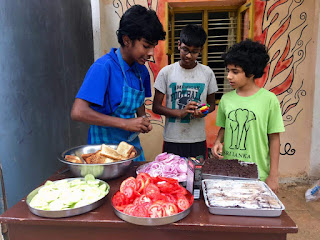It was shop time at Shibumi on Thursday, Oct 4th and it was the turn of the Malhars and Bihags to set up
shop. Well laid out plans were showing in the way each stall was put out; painstakingly prepared,
tastefully arranged, ready to be sold. But then, who hasn’t heard that the best-laid plans can go awry.
Rain arrived half-way through. Mid afternoon rain has a mind of its own. It pours, then stops, you step out,
it changes its mind and comes down again. Thankfully, the children were unaffected by it.
All in all it was great fun. We posed a few questions to the shopkeepers and this is what they had to
say about playing ‘shop shop’.
shop. Well laid out plans were showing in the way each stall was put out; painstakingly prepared,
tastefully arranged, ready to be sold. But then, who hasn’t heard that the best-laid plans can go awry.
Rain arrived half-way through. Mid afternoon rain has a mind of its own. It pours, then stops, you step out,
it changes its mind and comes down again. Thankfully, the children were unaffected by it.
All in all it was great fun. We posed a few questions to the shopkeepers and this is what they had to
say about playing ‘shop shop’.

1. How did you get the idea?
- I got it from my mother.
- We were inspired by food stalls on the roadside.
2. Were you able to implement your ideas?
- We couldn’t implement Marvel theme because we felt the youngest children might not understand.
- We planned to have more items but it didn’t happen.
- Three shopkeepers didn’t turn up making it difficult for the rest of the team.
- We had big plans and accomplished all of them.
- Even better, we earned eight times the money we invested.
- No! The juice can got knocked over.
- Uff! My friend hurt his finger.
- Oh no! We forgot to make the lemonade.
- Umm! The potato wedges were not baked enough.
- We didn’t expect to sell much, so we priced our items low. But still people rushed to buy them.
- Not at all! Not everyone knew about the games. Maybe the position of our shop was wrong.
- Aaahh! Why did it have to rain? No one came to play our games.
- ‘Someone asked ‘Can I bet on all the slots?’ in our roulette game’
- ‘Many of them ordered chocolate dosa’
- ‘Our sandwiches were a big hit!’
- ‘Chip chaat was loved by all’
- ‘The demand was so high that we started auctioning off items’


5. What aspect of ‘shop’ did you stick to?
- Kept the appearance appetizing and attractive.
- Priced it well and didn’t succumb to bargaining.
- Strictly no return policy (just ask the person who bought the fairy lights!).
- Took a loan and still made a profit.


6. Anything you want to tell future shopkeepers at Shibumi?
- Pricing is very important. Take time to do that.
- Be careful about the quantities.
- Think about advertising.
- Right position for the shop is everything.
- Think out of the box! A bento box!










Comments
Post a Comment